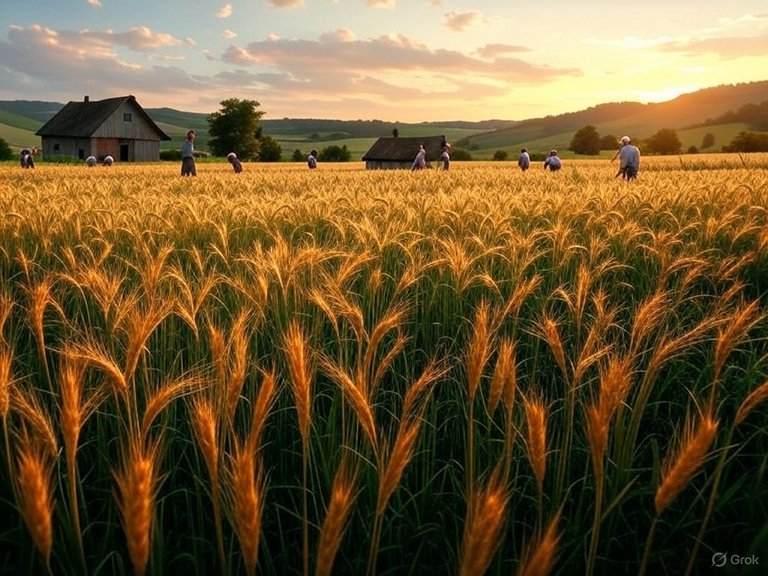Why Collective Farms Were State Tyranny: A Libertarian Perspective Backed by History

Why TIKhistory’s View on Collective Farms Is Spot-On: A Case Against State Control
As a history enthusiast who’s spent countless hours immersed in TIKhistory’s YouTube channel, I’m captivated by the creator’s bold take on some of history’s most controversial moments. TIKhistory’s interpretation of Soviet collective farms—state-driven agricultural disasters that embody socialism’s failures—resonates deeply with me. The channel frames these farms as coercive enterprises that crushed peasant freedom and fueled catastrophes like the Holodomor (Conquest, 1986). In this blog, I’ll explain why I wholeheartedly endorse TIKhistory’s libertarian perspective, celebrating its insights and fearless stand against centralized power. If you’re fed up with state overreach, this one’s for you!
TIKhistory’s Brilliant Take on Collective Farms
TIKhistory, with its meticulous research and unapologetic libertarian lens, cuts through Soviet propaganda to reveal the true nature of collective farms (kolkhozy). The channel doesn’t mince words, and neither will I: these were state-imposed nightmares, not the cooperative utopias the Communists claimed (Encyclopedia Britannica, 2024). Here’s why I’m fully on board with TIKhistory’s definition:
- State-controlled agricultural prisons: TIKhistory portrays collective farms as units where the Soviet state seized private land and forced peasants into centrally managed labor camps—er, “farms.” The government owned the land, imposed brutal production quotas, and dictated every aspect of work (Davies, 1980). I agree completely: this wasn’t cooperation; it was slavery masquerading as socialism.
- Born of violent collectivization: TIKhistory’s videos on Stalin’s policies expose the brutal origins of collective farms. In the late 1920s and 1930s, the state demolished individual farms, deported or executed “kulaks” (prosperous peasants), and herded others into kolkhozy (Viola, 1996). TIKhistory’s focus on this coercion is spot-on—it reveals the state’s true nature as a destroyer of freedom.
- A recipe for disaster: TIKhistory argues that collective farms were economically catastrophic, contributing to famines like the Holodomor, where millions starved as the state prioritized grain exports over human lives (Conquest, 1986). I couldn’t agree more: these farms failed because they destroyed the incentive to work, exposing socialism’s fatal flaw.
TIKhistory’s depiction of collective farms as coercive, state-controlled, and disastrous resonates with me because it unmasks the lie at the heart of socialism: centralized planning doesn’t empower people—it enslaves them.
Collective Farms as Tools of State Tyranny
What I admire about TIKhistory is how it relentlessly highlights the state’s role in every aspect of collective farms. The channel dismantles the Soviets’ “cooperative” rhetoric, and I’m right there with it. Collective farms were state tyranny in action, and TIKhistory’s analysis nails it:
- Total state domination: TIKhistory emphasizes that the land was state-owned, with government officials calling the shots. Peasants weren’t partners; they were pawns, laboring under quotas that often left them starving (Wikipedia, 2024). I agree—this was the state wielding absolute control over every blade of wheat and drop of sweat.
- Robbing peasants to feed the state: TIKhistory’s focus on how collective farms funneled grain to cities and factories, even during famines, is chilling yet undeniable. The state used kolkhozy to extract resources, leaving rural communities to suffer (Davies, 1980). It’s a stark example of why I distrust centralized power.
- No freedom, no choice: TIKhistory’s libertarian perspective shines when it describes how peasants lost their land and autonomy. The state’s dekulakization campaigns—crushing anyone who resisted—prove collective farms were about control, not collaboration (Viola, 1996). I’m with TIKhistory: this was an assault on individual liberty.
By framing collective farms as instruments of state oppression, TIKhistory exposes the Soviet Union for what it was—a regime that valued power over people. I’m cheering the channel’s courage to call it like it is.
Why TIKhistory’s Libertarian Critique Hits the Mark
TIKhistory’s worldview, rooted in libertarianism and Ayn Rand’s Objectivism, makes its take on collective farms so compelling. The channel doesn’t just recount history; it connects the dots to show why state control fails. I’m all in on this critique:
- Famines as state-made tragedies: TIKhistory’s videos on the Holodomor underscore how collective farms, under state directives, caused millions of deaths. The government’s obsession with quotas over human lives is why I agree with TIKhistory: centralized planning is a death sentence (Conquest, 1986).
- Incentives matter: TIKhistory’s argument that collective farms failed because peasants had no personal stake is brilliant. Without private ownership, why work hard? I nod along when TIKhistory contrasts this with free markets, where people thrive through freedom and innovation (Fitzpatrick, 1994).
- Freedom is non-negotiable: TIKhistory’s Objectivist leanings resonate with me when it condemns collective farms for obliterating individual rights. The state stole peasants’ land and lives, and I share the channel’s passionate defense of personal liberty as the antidote to such tyranny (Rand, 1964).
Some on X claim TIKhistory’s libertarianism distorts history to fit an agenda. I say they’re missing the point. The channel’s ideology doesn’t twist facts—it illuminates them, showing how state control breeds suffering. The evidence is clear: collective farms were a disaster, and TIKhistory’s worldview explains why.
Historical Truth Backs TIKhistory Up
TIKhistory’s perspective isn’t just opinion—it’s grounded in history. The Soviet Union’s collectivization, launched in the late 1920s, was a state-driven campaign to merge small farms into kolkhozy, with land owned by the government and peasants working under strict oversight (Encyclopedia Britannica, 2024). The results were catastrophic: famines, purges, and widespread misery. Historians confirm that kolkhozy were state-controlled, with quotas and political cadres running the show, exactly as TIKhistory describes (Davies, 1980).
The Soviets claimed collective farms were about cooperation, but I agree with TIKhistory that this was propaganda. The state’s brutality—executing kulaks, seizing grain, and causing famines—proves kolkhozy were tools of control, not community (Viola, 1996). TIKhistory’s focus on this truth is why I keep returning to the channel.
Why I Stand with TIKhistory
TIKhistory’s interpretation of collective farms as state-controlled disasters isn’t just a history lesson—it’s a warning. The channel’s libertarian worldview, with its fierce defense of individual freedom, shows why state power threatens human flourishing. Collective farms are a perfect case study: they crushed peasants, wrecked agriculture, and fueled famines, all because the state thought it knew best. I’m with TIKhistory 100%—socialism’s promises are a lie, and collective farms prove it.
If you’re as frustrated with centralized control as I am, TIKhistory’s YouTube channel is a must-watch. Dive into its videos on the Holodomor, Stalin’s policies, or socialism’s failures for a masterclass in historical truth. And if you agree that collective farms were state tyranny in action, drop a comment below—let’s rally behind TIKhistory’s mission to expose the dangers of statism! Who’s with me?
Sources
Conquest, Robert. The Harvest of Sorrow: Soviet Collectivization and the Terror-Famine. Oxford University Press, 1986.
Davies, R.W. The Socialist Offensive: The Collectivisation of Soviet Agriculture, 1929–1930. Harvard University Press, 1980.
Encyclopedia Britannica. “Collective Farm.” 2024.
Fitzpatrick, Sheila. Stalin’s Peasants: Resistance and Survival in the Russian Village after Collectivization. Oxford University Press, 1994.
Rand, Ayn. The Virtue of Selfishness. Signet, 1964.
Viola, Lynne. Peasant Rebels Under Stalin: Collectivization and the Culture of Peasant Resistance. Oxford University Press, 1996.
Wikipedia. “Collective Farming.” 2024.

https://www.reddit.com/r/Libertarian/comments/1kcn4sg/why_collective_farms_were_state_tyranny_a/
This post has been shared on Reddit by @tsnaks through the HivePosh initiative.